

MCT thru-hikers need at least three days to cover all the island parts on the official route.
They are concentrated in the southern parts of the MCT route. That means sea travel happens at a very early stage of the MCT thru-hike for the northbound hikers. On the other hand, the southbound hikers will come just before reaching the south trailhead goal.
We have already done the first of them, the Urato islands, only 2 days ago.

So today, on our Day 9, and tomorrow, we will do the rest, two of the three, and we are done.
No more dealing with time-restricted ferries and island hikes. Until we get to our goal, the north trailhead, in 40 days or so, we will stay on the mainland and have no complications we have to plan ahead carefully.
This was indeed one of the reasons why we picked going northbound.
The Ajishima Line ferries
The second sea travel and island hikes was the Tashirojima Island 田代島and Asjishima Island 網地島.
Hikers need to take ferries 3 times to go through this part. Leaving from the ferry port in downtown Ishinomaki city and then hiking on the two islands, our goal for the day would be Ayukawa port 鮎川港, located at the edge of the Oshika peninsula 牡鹿半島.

Unlike the other two “sea travel and island hikes” parts, we didn’t need any advanced pre-booking for ships this time. Instead, we used regular public ferries. The Ishinomaki municipal ferry, called the Ajishima Line 網地島ライン, connects downtown Ishinomaki, Tashirojima Island, Ajishima Island, and Ayukawa Port. Although the Ayukawa port looked like the other side of the sea, the Oshika peninsula is still a part of Ishinomaki.
On the other hand, the reason why we needed to arrange the special MCT supporter’s fishing boat from Sabusawajima island 寒風沢島 to Miyato island 宮戸島 was Miyato is not a part of the Shiogama city 塩竈市 as Sabusawajima is. Therefore, the Shiogama public ferries don’t go to the different municipal areas.

As the time schedule shows, the Ajishima line ferries run 3 to 5 times daily, depending on the season.
However, MCT hikers must remember that there is only one set of ferries to take if you want to go through the entire part in one day.
- Ishinomaki port
- Nitoda port
- Futawatashi port
09:00
13:34
16:38
To Odomari port (Tashirojima)
To Aji port (Ajishima)
To Ayukawa port (Arrival at 16:50)
¥1250
¥350
¥470
Also, compared to the three islands of Urato we walked 2 days ago, the Tashirojima and Asjishima islands are much larger. The MCT route length on each of them is about 5km.
In the Urado islands, we could call the on-demand base small ships to cross between the three islands whenever we arrived at the boat decks, which was really flexible and no stress. But this time, we must make it on time for the public ferries to cross the water each time. If we miss it, we will be literally stuck. There seemed to be a couple of small minshuku on the Ajishima island, but, considering it was off-season, especially in the middle of COVID, we didn’t want to just rely on luck.
The second islands route section on the MCT
The taxi we arranged last night for pickup was already waiting for us at the hotel entrance when we checked out at 8:10 in the morning.
The quiet but experienced driver smoothly took us to the Ishinomaki Chuo port 石巻中央 by 8:25.

After purchasing the ferry tickets conveniently from a ticket machine, we waited until the crews finished up the preparation and let us on board.


We bought tickets only to our first stop, the Ōdomari port 大泊 of Tashirojima island, for ¥1250 per person. Though we needed to get two more ferry tickets later today, we could buy those tickets on each ferry.
Surprisingly, much more passengers than we expected were gathering in front of the ferry, and we realized today was Saturday. More surprisingly, many were young tourists in their late teens or early 20s, and mostly couples looking on a weekend date. Some others were young guys carrying their backpacks and fishing rods.
It was an interesting contrast from the last Urato islands ferry, whose passengers were residents or workers of the islands.


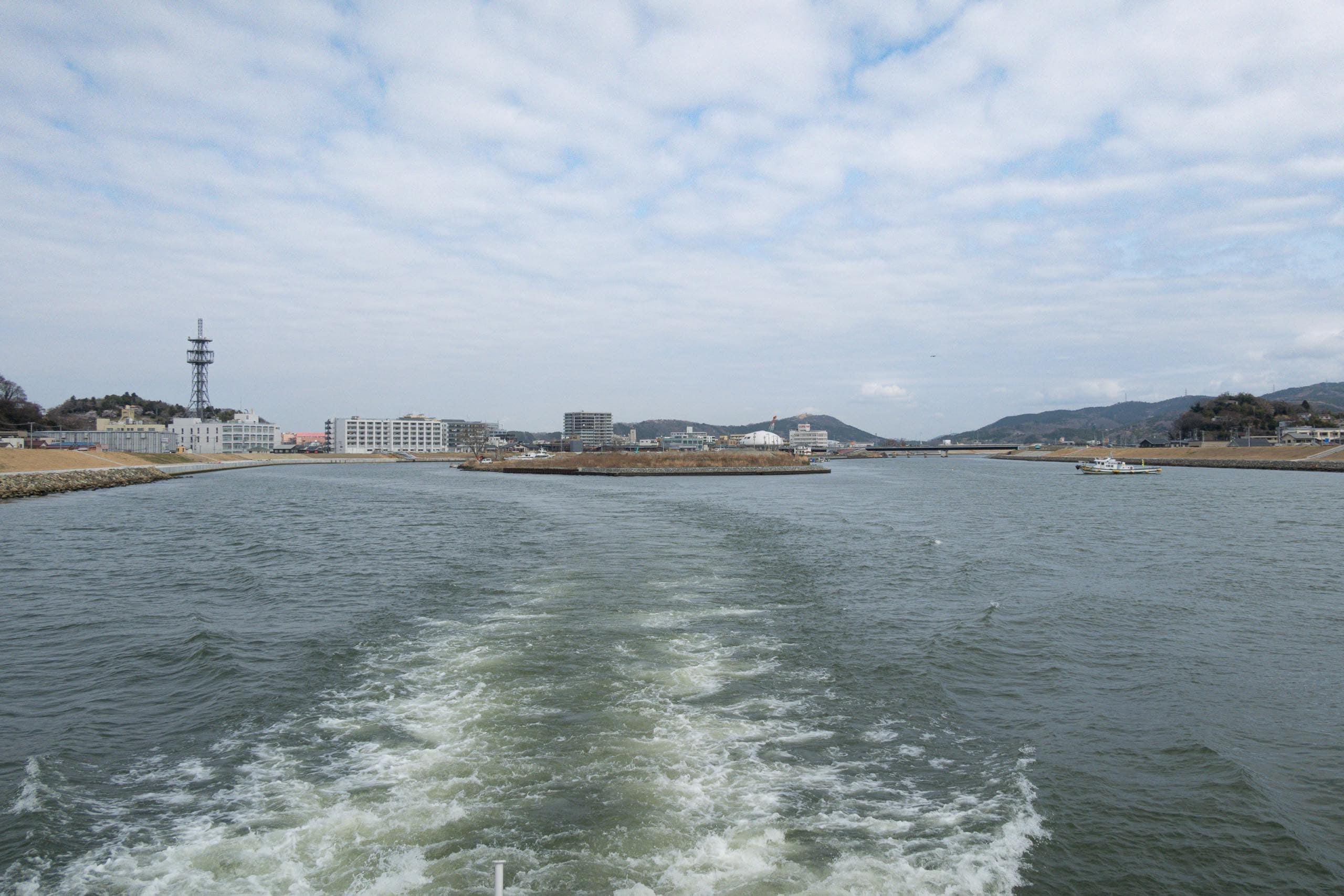
The ferry departed and went down the last part of the Kyu-kitakamigawa River. Before going out to the ocean, the ferry stopped at another port, Kadonowaki 門脇, and had some more passengers who left their cars in the ferry port’s parking area.


Another sunny, lovely day, we stayed on the deck to enjoy morning sea breezes for the entire 30 minutes while on board.
The Cat Island – Tashirojima

Only a few people, including us, got off at Ōdomari.
We were sure that most others would get off the next port on the other side of the island.
Tashirojima island is nationally well-known as “the cat island” and has become increasingly popular among young cat lovers. As a matter of fact, no dogs are allowed to come on this island.


A long time ago, Tashirojima thrived with fishery and was very populated. But now, we saw only a few houses around here, and everything was deadly silent.
From the nationwide fame of this cat island, we expected big crowds of cats would be waiting – just like another internationally famous rabbit island in the Seto inland sea, where visitors could see the sea of rabbits literally covering the entire ground.
Well, the reality here was…we saw only one cat walking around.

Probably, cats knew most visitors got off at the other port and had moved in that direction for more efficiency. After the first glance, the cat immediately lost interest in us to figure out we didn’t have cat food.
By a tiny shelter for ferry passengers to wait in bad weather, there was a new map of this island, and the MCT route was shown with dot lines too.
Another thing that caught our eyes was a black buoy placed by a narrow path covered with white letters.
In Japanese and English, the letters said, as if it was screaming, not to put cat food on the street.
We could clearly imagine what kind of situation was going on pre-COVID time. First, floods of tourists came to this quiet island, walking around and being loud as they chased and fed cats. Then, leaving uneaten cat foods scattered all over the path residents regularly walk, rotten cat foods called flies and birds poops…

Near the caution buoy, we found a sort of folkloric site called the Kobo Daishi well 弘法様の井戸.
“Look. Apparently, Kobo Daishi came to even Tohoku.”
“Of course, it is Kobo Daishi!”

As residents of Tokushima 徳島県 in the Shikoku Island 四国 and also both of us had done the Shikoku Pilgrimage 四国遍路 multiple times, we were pretty amused with this finding. It should be hard to get why this was funny for those unfamiliar with the Shikoku Pilgrimage and Koyasan 高野山.
Not only in Shikoku but in western Japan, there are thousands of unbelievable legends and folklore about what the great Kobo Daishi 弘法大師 was said to have done. Furthermore, whenever we went long-hike in more eastern and northern parts of Japan, there was no place we didn’t see any Kobo Daishi-related site.
So we had enjoyed finding where would be the most northern Kobo Daishi front, and now this well on a tiny island of Tohoku broke the record.
Before walking up the MCT route, there was a torii gate and narrow, steep stone stairs to a shrine.
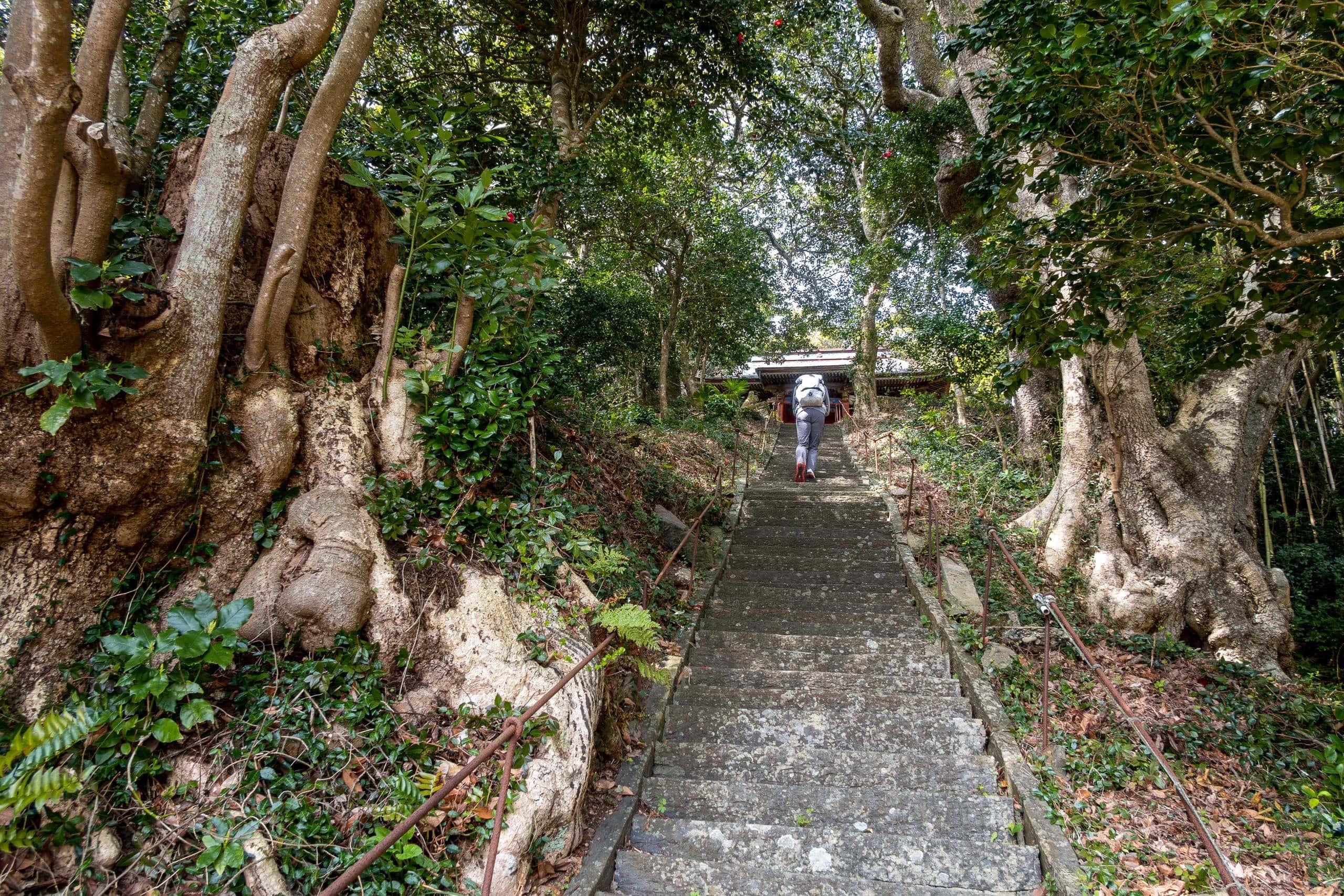
As a warm-up to prepare for the long walk, we walked up the stairs and found a quaint red shrine guarded by stocky old trees.



Around the shine and along the first part of the MCT route, trees and plants had a more tropical island atmosphere, despite the northern region of Japan.

We didn’t see any trace of the past glory of this island; instead, most areas seemed long-abandoned and were covered with forests of different types of trees and grasses. But unlike the mainland, the population here was too few to have a littering problem, so the bushes and forests looked neat in conformity with nature.
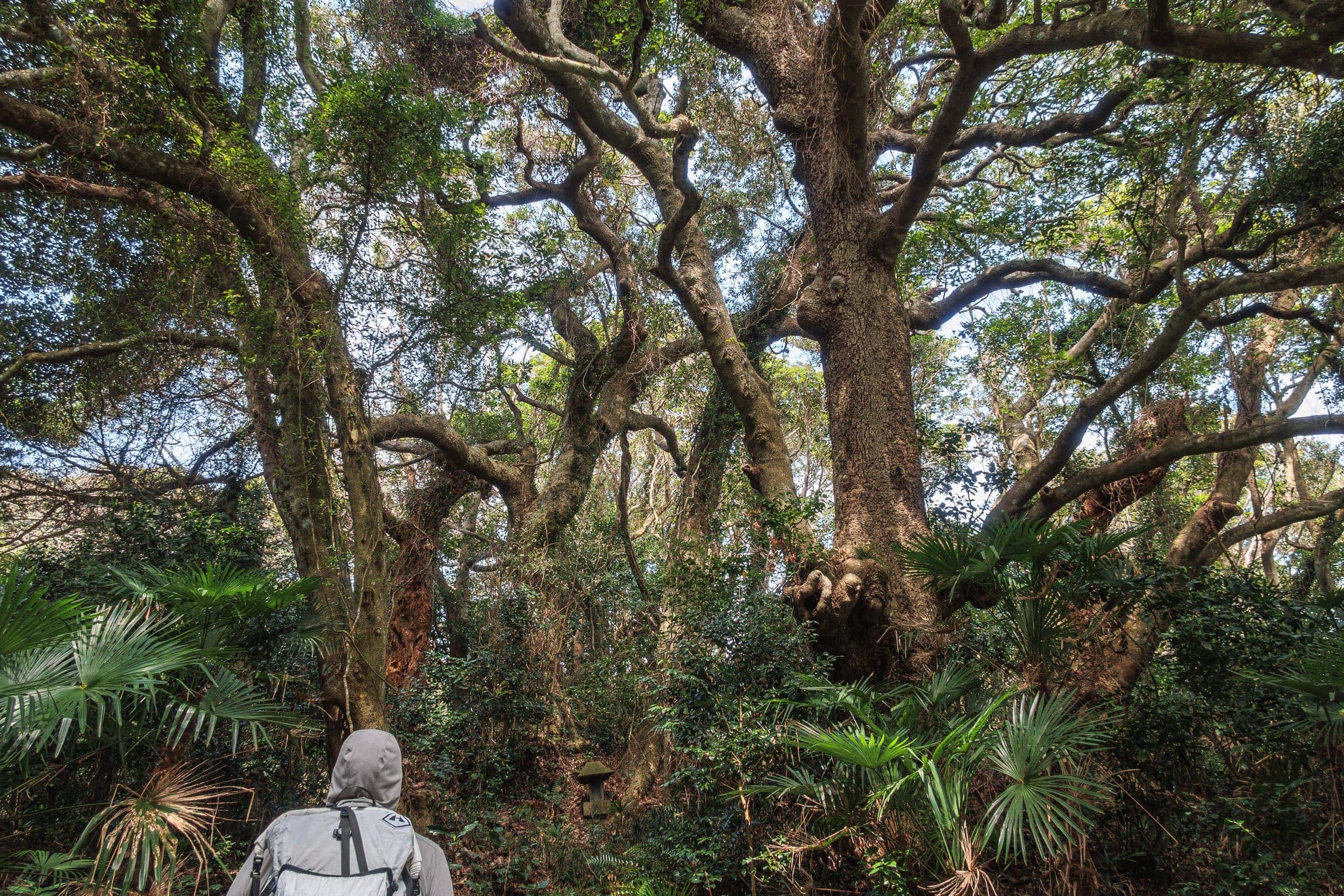


The Cat shrine
Naturally, route signs here seemed set to serve only cat-seeking visitors, not the MCT hikers. We missed the first critical corner we were supposed to turn right to follow the MCT route because all the wooden arrows at the corner pointed going straight. (yes, we should have checked the map…)

As we kept walking on the narrow road, unaware of taking the wrong way, we saw a few young couples ahead of us. They looked like they were feeding cats small dried fish, and a small group of cats was following them.
We found a tiny white-wall shrine. Many ceramic cat dolls in various shapes and sizes were placed in front.

We saw a couple of cats comfortably sunbathing at the corners of the shrine area.
It was pretty common to see more cats walking around fishermen’s villages than in regular cities and towns where wild cat/dog control is rigorous. Traditionally, people appreciate cats because they catch mice who eat the human’s stocked foods. Besides, sericulture was very big in Tashirojima in the early modern period, and cats also guarded silkworms against mice.
Cats were also considered lucky charms for great fish catches among Tashirojima islanders. Plenty of extra fish for cats from the thriving fishery, and the grateful people treated cats well, so this island became a cat paradise.

Unsurprisingly, the shrine we found enshrines a cat god, Nekogami-sama 猫神様 in Japanese.
According to an information board at the shrine, fishermen were breaking rocks to make anchors one day, and friendly cats hung out around them as usual. Unfortunately, a broken piece flew off and crashed one of them. Feeling so sorry and sad, the fishermen built a shrine dedicated to the poor cat to pray for cats’ safety and continuous big catches.
The Cat café at the highest point on the island
Still not realizing the wrong path, we walked through thick walls of thin bamboo, standing on both sides of the road to arrive at a former elementary school turning a café with a cat goods shop 島のえき.

On the front deck, more young couples enjoyed stroking and patting cats, and some other cats were rambling or taking naps around.


There was a vending machine, so we got drinks and had a break… and yes, we finally realized we had come the wrong way.
The road we took was the direct road connecting the two ports on this island. The former school cat café was not that far from the other port, so most young visitors on the same ferry with us got off and came to this café from that direction.
We had to walk back to the point we missed the turn. But it was not that all bad. We still had more than enough time till the next ferry time. The cat shrine and the cat café were not along the MCT route, so if we had followed the route, we would have missed two of the most popular sites on this island.
The correct route goes along more outline of the island.




There was no sign of houses or residents’ life on this side of the island. Many flatter areas were covered entirely with dry grass along the concrete-paved farming path. These areas were getting plenty of sunlight, so there must have been rice parries or vegetable fields long ago. Beyond them, we could see the blue ocean.

Cape Mitsuishizaki
The most strange point about the MCT route in Tashirojima was it didn’t go to the most popular places, such as the cat café and the shine.

Also, we had to make short trips off the route to see some other scenic sites.
We did pass seemingly some remains of old glory on this island, but all the information signs were rusted, and fallen plates were left on the ground.
Also, a creepy-looking dusty portable toilet randomly standing by the path with a sticker showing this is a “pay toilet.” Not only did we not find out how we could pay, but also we were too scared to open the door and see inside, so we left it untouched.


At a fork, we found a small sign directing us to a side forest path for the Mitsuishi Kannon 三石観音 cliff, 400m from there. On the MCT official map, this point was marked as “turn for cape Mitsuishizaki 三石崎”.
After carefully considering our walking speed and the distance and time left to get to the next port on time, we decided to follow our curiosity.



The Kannon temple was not that impressive, to be honest, much tinier and newer than we expected. The earthquake probably destroyed the original old temple building 10 years ago, and the wooden parts were slowly returning to the earth behind the newly built small temple.
Still, we were glad that we came this way as the cliffs and the ocean view from there were breathtaking.

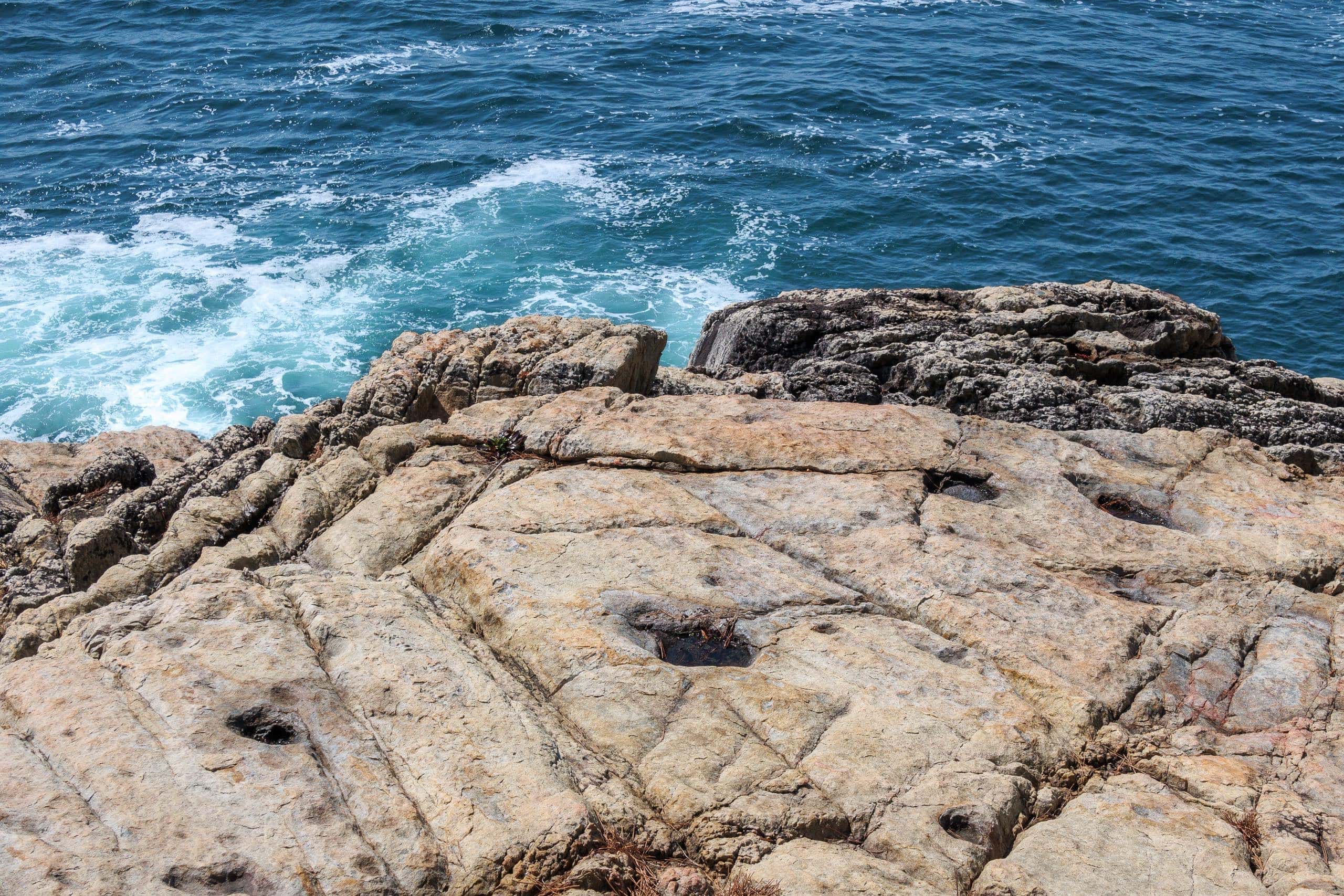

One of the cliffs was maintained as a viewpoint with a gazebo where three different camping methods were set up between pine trees. The owners were on the wave-washed rocks below the cliff, enjoying saltwater fishing.


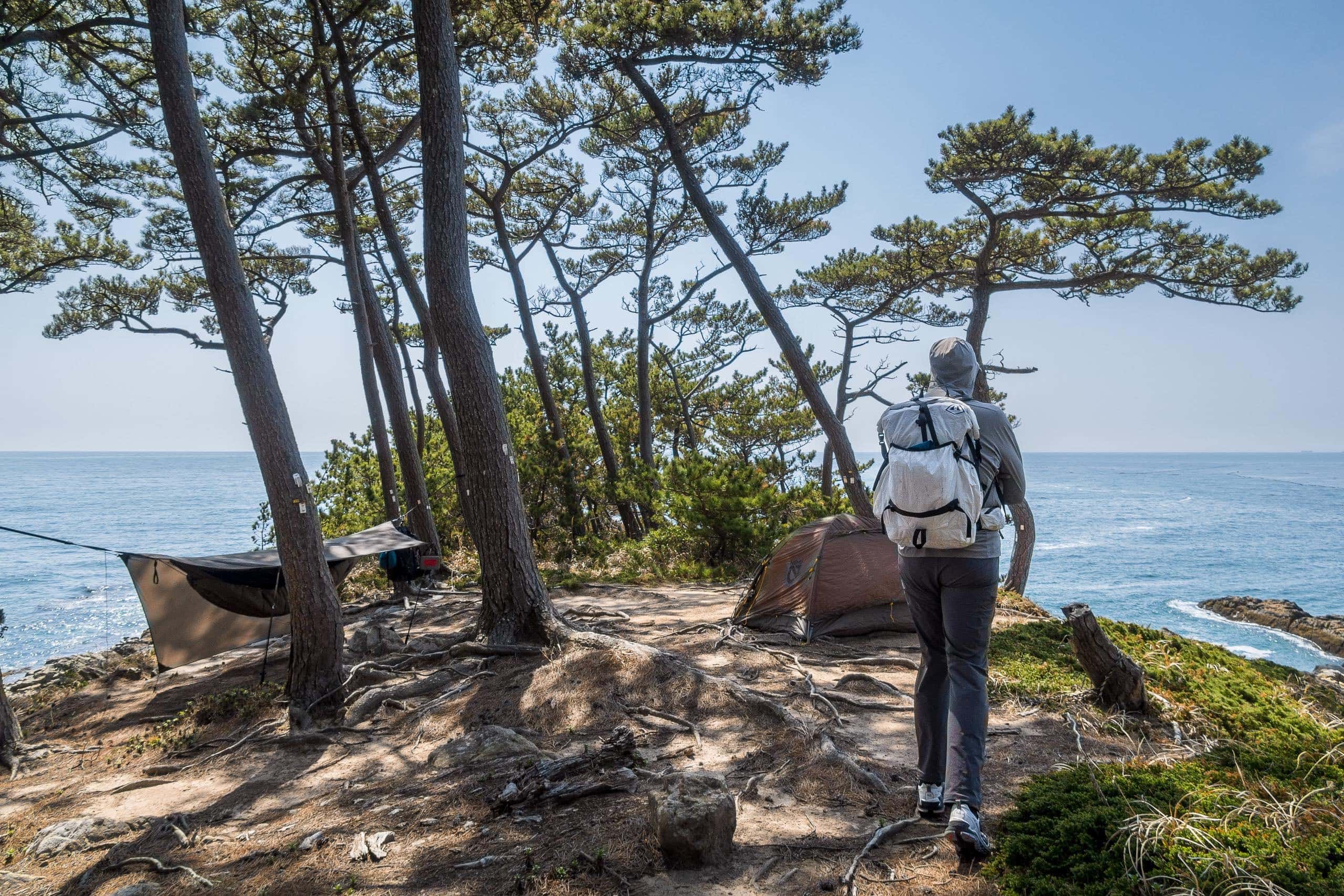

We walked back another 400m to rejoin the MCT route. We had come about halfway through the route on Tashirojima at this point.
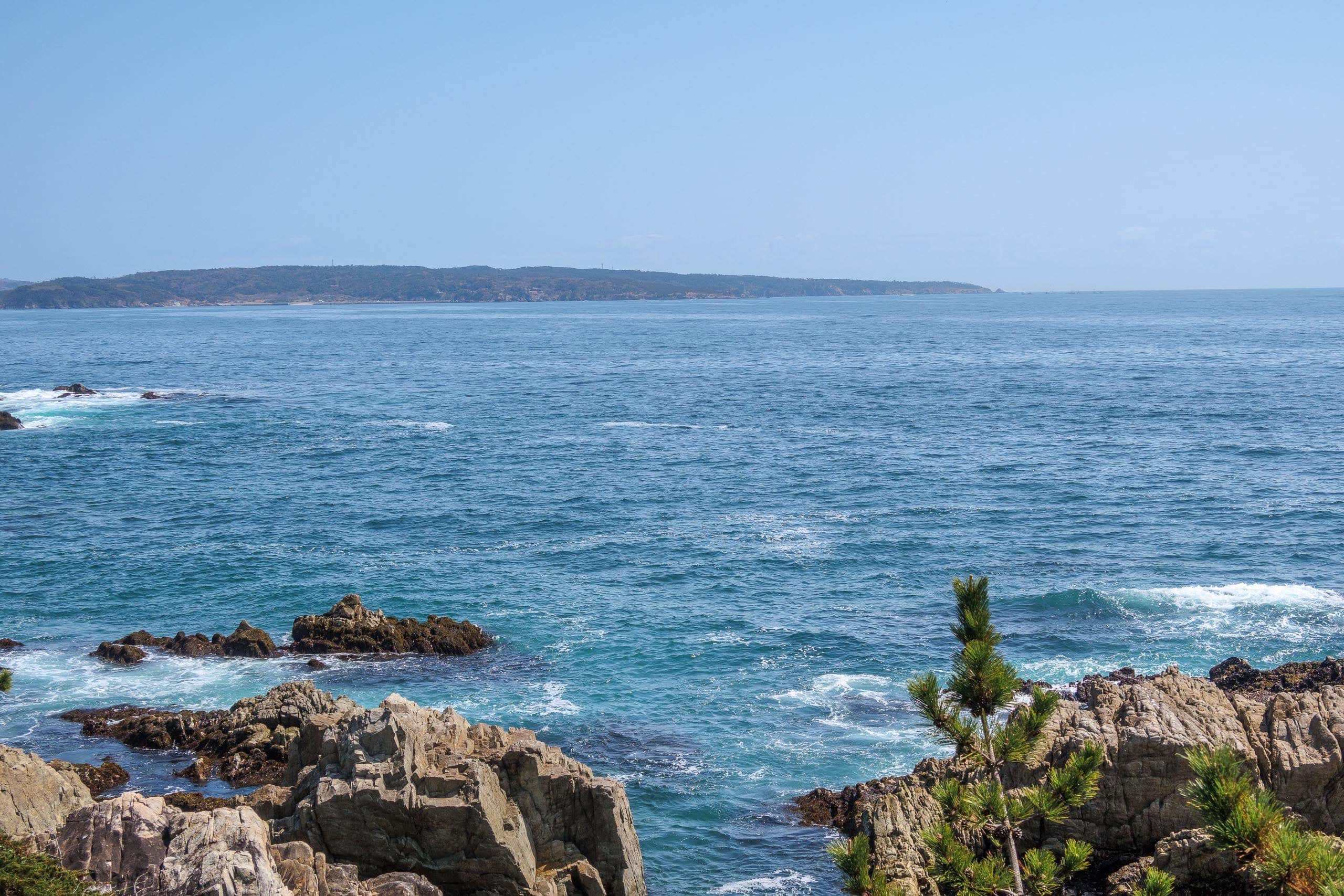
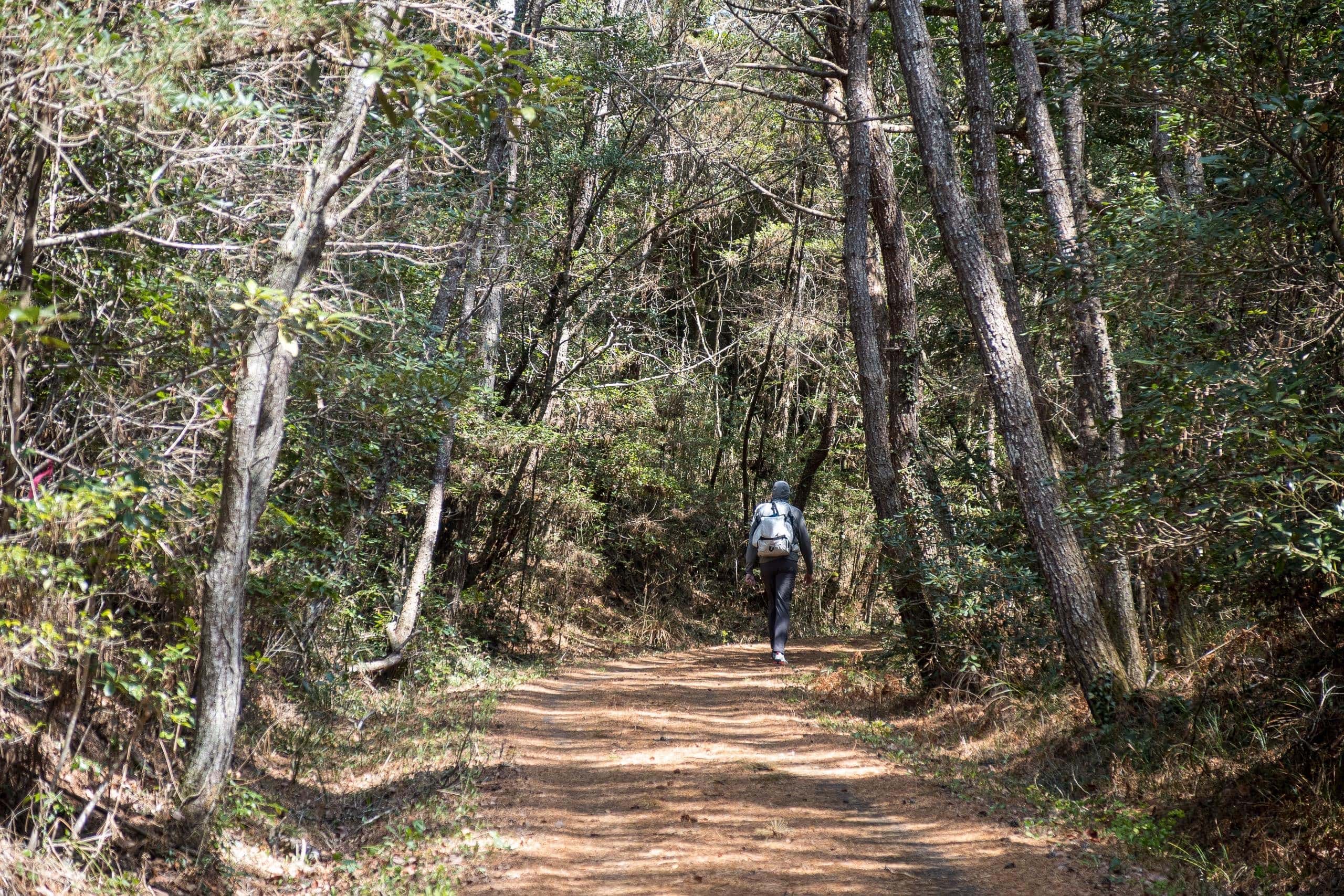
The rest half of the route was the same monotonous-looking narrow path between bamboo bush walls and pine forests.
The MANGA island campsite
The last notable site on cat Island was the MANGA island campsite マンガアイランド.

According to travel websites and magazines, this place was very popular as all five lodges are cat-shaped and have cat-themed interior designs.
Each lodge has bunk beds, a kitchen, a toilet, and a small shower room, which is very good for groups of cat lovers to stay in. Unfortunately, we were here off-season ( late April to the end of October), so both lodges and tent sites were closed, and no one was at the administration office.

We only enjoyed walking around a bit and a clear view of the next island, Ajishima, over the blue water and then left to go down to the port.
This side of the island was much more populated and had many more houses. Still, the population on this fast-aging island is only 60 people (and twice as many cats). That means most homes we saw were probably unoccupied. From the beginning to the end, this island was very quiet other than the sounds of ocean waves and the voices and laughs of tourists.
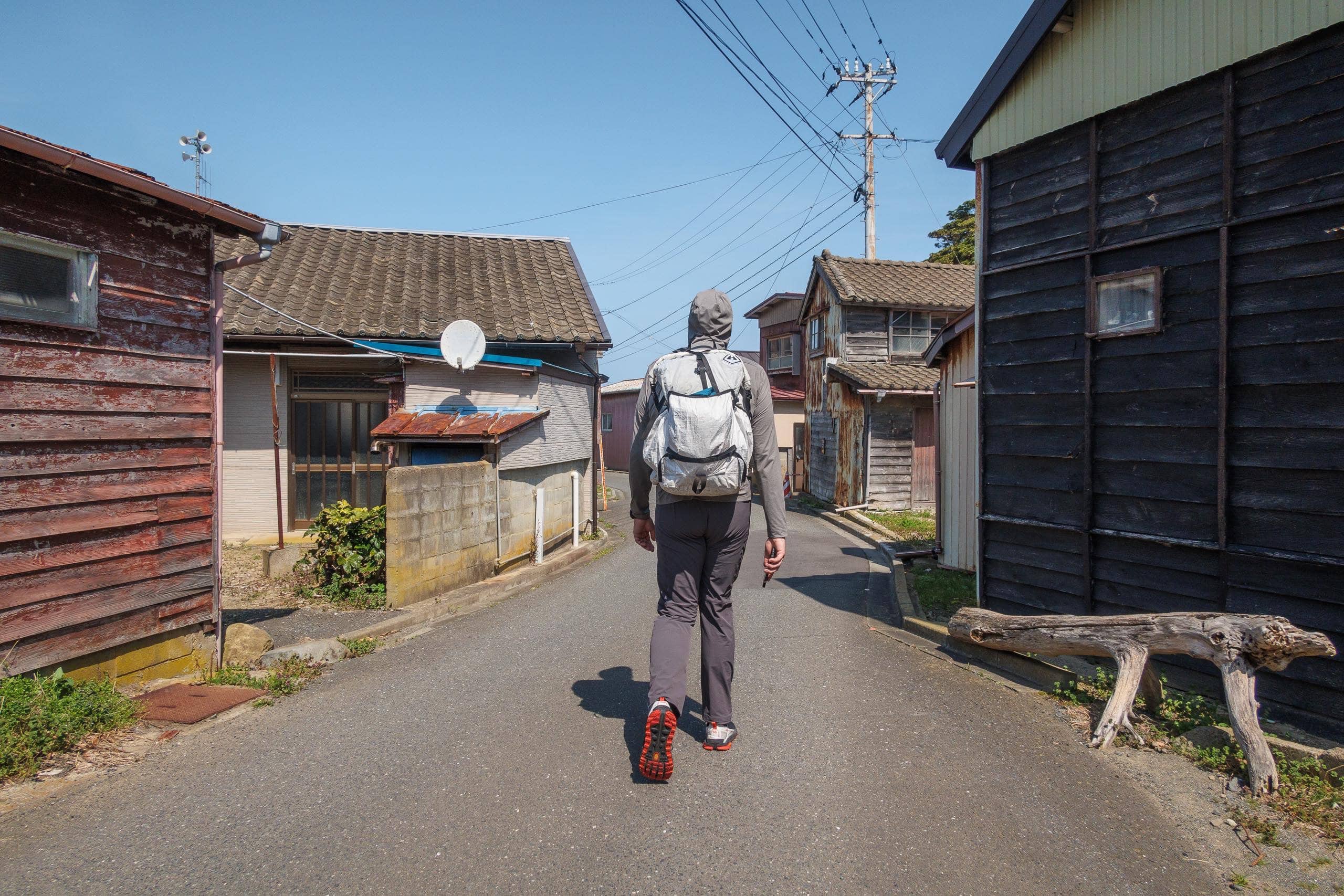

We had to wait until the next ferry arrived, examining the hand-made information board. On top of the board, the green arrow was “few cats,” and on the other hand, the red arrow was “many cats.” That was indeed the most essential information for all tourists. In addition, the board had graphic charts about which food was harmful or even poisonous to cats. The newest-looking notes said, “Do NOT feed the cat” to protect their health.


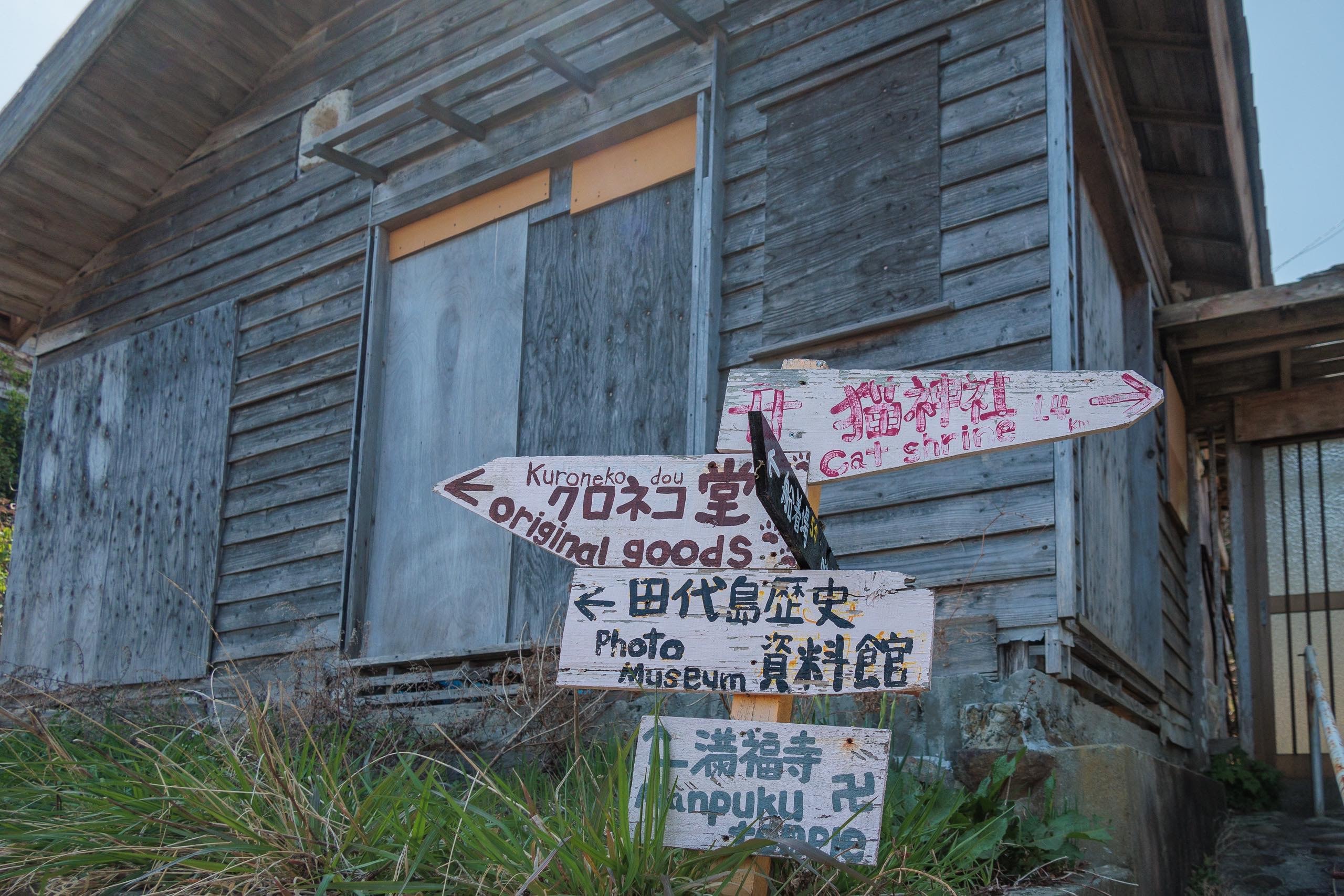
A few local elders with hand carts were waiting by the ferry deck. When the ferry arrived, crews handed them boxes and bags. Must be life necessities they had ordered, as we didn’t see any grocery and daily goods stores on this island.


Many more young people cheerfully got off the ferry. On the other hand, a few young couples who were at the dock didn’t get on. Probably they were taking another ferry to go straight back to Ishinomaki. So we ended up being the only ones getting on the ferry.



The Ajishima Island
The second island today, Ajishima, had a more lively atmosphere.
That’s what we felt as our ferry was approaching the north port, Aji 網地.

But our impression was possibly affected by a cheerful family with two little girls on the same ferry.
As soon as the ferry arrived at the deck, the girls spotted another family with a little girl waiting for them waving. The little girls, skipping and screaming in joyful excitement, dashed to them as we got off. Friends or cousins, the girls were hugging each other.

Good that this island did have a younger population. In fact, the number of residents on this island is a little less than 300, still much more than cat island, with only 60 people.


The ferry passengers’ waiting room was a nice fish-looking hut with a bathroom.
Then, before following the MCT route, we entered the white-sand beach next to the port. The Aji Shirahama swimming beach 網地白浜海水浴場 is the most popular beach in Ishinomaki for its very clear emerald-green water, very busy during summer. But now, in early spring, no one but us was there to enjoy the peaceful view of very calm waves washing beach sands.

At a corner of the beach, we found three stone monuments with a bronze statue of a western man.

The Denmark-born explorer Vitus Bering led the Russian expedition team and visited this island in 1793. They exchanged some goods and probably food and water with the Japanese islanders then. Today, that event is marked as the first Russia-Japan trade in history.

The MCT route in Ajishima consisted of two types of trails: unpaved trails through bamboos and native trees forests and a boring long stretch of main car road connecting the north village and the south village. The broad nature area in the middle of the island completely separated the two villages, and the car road cuts straight through it like backbones.
Paths between houses in any fisherman village are usually narrow and complicated. Following the MCT stickers and tapes attached to the poles and fences, we navigated through the quiet little village.


The signs led us into the wildly thick bushes of thin and tall bamboo, which eventually formed a long tunnel we would feel hesitant to step in if not clearly marked.



The following forest walk was quite enjoyable as the beautiful contrasts of shadows and sunlight through freaky-shaped trees.



But the forest path connected to the paved two-lane car road, and we had to walk more than twice longer distances on it.
We passed a former school along the road, which seemed to turn into a facility for youth summer camps or school trips, not open to the public, unlike the cat café on Tashirojima island.



Instead of going on the last several hundred meters of the road, the MCT route went into the side forests and traced an old unpaved farming road through the trees.




After making a big 2km detour, the path rejoined the original paved car road. So, if you need to hurry to the port, you can just skip this detour and keep straight on the road.
From this rejoining point, the correct MCT route goes along the car road straight down to the south port, Futawatashi 長渡.
We checked the time to ensure we had enough time to go and see the cape Dowamekizaki lighthouse, which I got interested in from the information map at the north port.
The lighthouse was supposed to stand on the south edge of this island, and we needed to walk about 2.5 extra kilometers to go there and return to the port. Looked like we had enough time to do it if we walked a bit faster and did not stay at the lighthouse too long.
We immediately went into a side road that goes through the south village. As the population of this island was nearly 300, the houses we passed by looked much more occupied and alive.



The red and white striped lighthouse looked cute in front of the deep blue Pacific Ocean, like a big pepper grinder on a blue tablecloth.

The name of the cape, Dowamekizaki 涛波岐崎 written in Kanji (Chinese characters) letters is extremely hard to guess how they are supposed to pronounce for the Japanese. One of the said origins of the name was the word, dowameki, describing the thunderous roars of wild waves battering the cape.
That was precisely what we saw beyond the lighthouse.
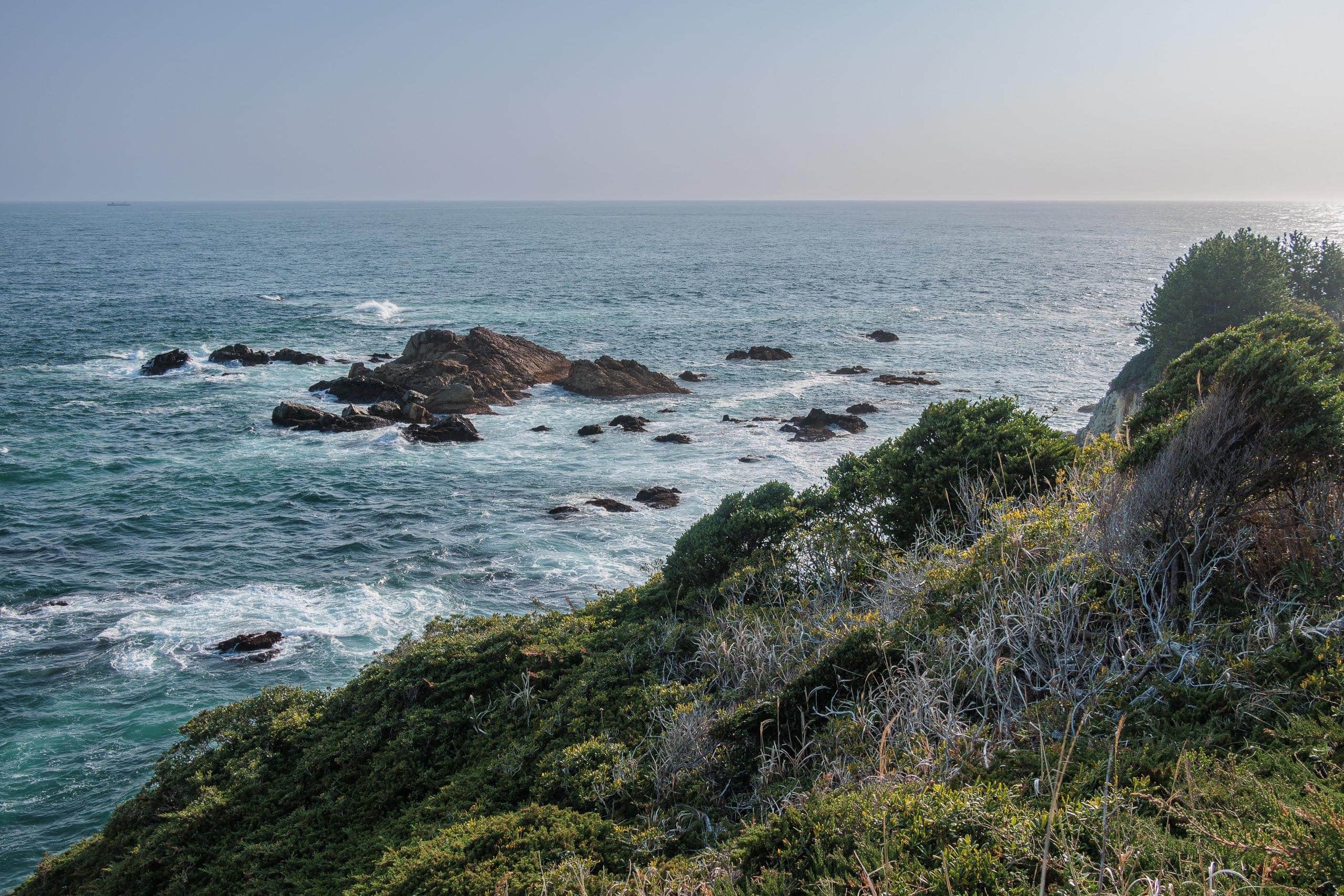
We walked down a thin path to the cliffs; the scenery there was just wondrous.
Dynamic movements of waves and their roars in the setting sunlight made us stunned there.


Then, looking to the left side, we got a perfectly clear view of a massive mountain-like island standing straight from the ocean.
That was the Kinkasan island 金華山, the last and the hardest-to-reach island on the MCT route we would hike tomorrow.

We were supposed to have 20 minutes to spend at the lighthouse, but the breathtaking views around the cape made us forget the time and stay too long.
Now we had only 20 minutes to the last ferry we must catch. So, for the last 1.5km to the port, we ran.
Erik likes running, so he would regularly go for running. But… Me? Well, I had no choice and ran seriously, for the first time after many many years, with the heavy backpack on my shoulders. Even if I had done similar things frequently in the Japanese Ground Self-Defense Force, that was really a past glory. I had not done any decent exercises during the last winter, sitting in front of my computer all day.
But I ran. Otherwise, we got stuck on this island tonight…


In the end, we made it to the port on time, thanks to all we had to run were downhills.
The ferry was even late…so late that we started feeling anxious if it might have already gone.
But, just like the last time on the cat island, local elders with their hand carts were gathering and chatting with each other, which was a good sign that they were still waiting for the ferry to bring the stuff they ordered.
My heart was thumping so hard and I was seriously out of breath after the hard run.
But I was trying to do my very best not to make crazy coughs not to frighten the vulnerable local elders on an isolated island in the middle of COVID fears spreading all over Japan…

There were only a few passengers on the ferry to Ayukawa port 鮎川港. So we sat on the empty outside deck to say goodbye to the two islands as the ferry slid fast through the waves to cross the ocean.

When we looked for accommodation in the Ayukawa area, all places near the port were already full-booked or temporarily closed.
Regularly, guests for those family-run minshukus are visitors for leisure fishing and probably construction workers to rebuild the natural disaster-battered areas. It was not high season for them yet.
Also, most minshuku owners are fishermen, and this time of the year seemed their busy season for harvesting seaweeds. So they had to focus on it and could not take care of their minshukus.
After zooming in and out the google maps multiple times and simulating the possible route options, we found a hotel a bit away from the port that provides free pickup/drop-off services for their guests. We booked a room for two nights there and arranged all times and locations for the car rides for the next two days.

We told the hotel we were taking the last ferry from Ajishima island. Arriving at the ferry port, we spotted a car and a politely standing man waiting for us right behind the port gate. He immediately recognized us, not only because so few people got off but also because it was hard to miss an unusually tall Dutchman.

On the way to the hotel, we passed a busy camping park. It was Saturday evening, so the tent sites were packed with family-sized tents and cars, enjoying barbeques. Since this new lifestyle with COVID started, camping grounds and parks were always full of families and friend groups enjoying the outdoors in the fresh air, whichever part of Japan we went to.
The hotel was located on the heights on the opposite side of Kinkasan island. From our room window, it looked so close that a good swimmer might be able to cross from here.

However, this is the island many hikers struggle to reach, and as a result, many past thru-hikers skip.
We call Kinkasan island the hardest and especially the most expensive island.
Why?
…Well, we will talk about it in the following article.
Day 9 – MCT
| Start | Ajishima Line Chuo Port |
| Distance | 46.1km (28.8km) |
| Elevation Gain/Loss | 373m/176m |
| Finish | Ayukawa Port |
| Time | 8h 6m |
| Highest/Lowest Altitude | 106m/ 0m |
The Michinoku Coastal Trail Thru-hike : Late March – Mid-May 2021
- The first and most reliable information source about MCT is the official website
- For updates on detours, route changes, and trail closures on the MCT route
- Get the MCT Official Hiking Map Books
- Download the route GPS data provided by MCT Trail Club
- MCT hiking challengers/alumni registration












Comments